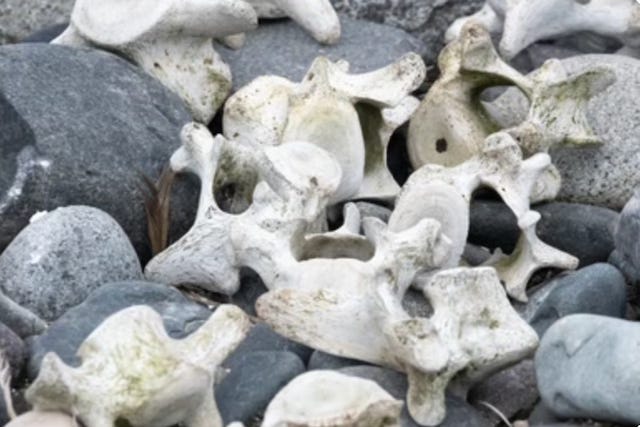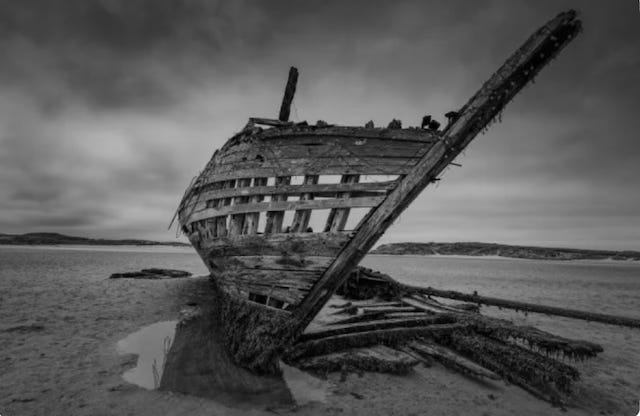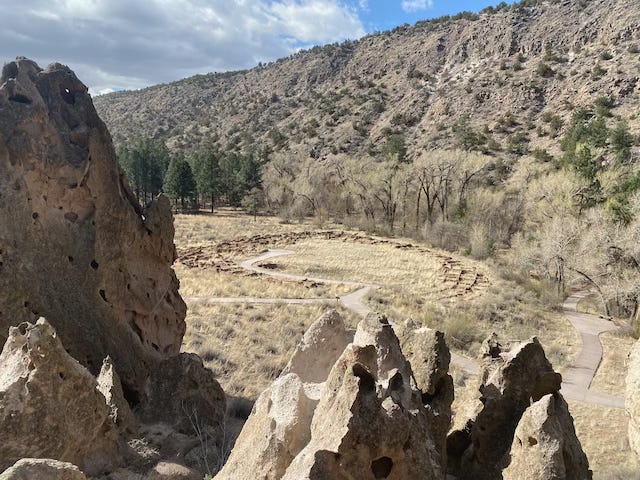Baja California, Mexico.
The vertebrae are bleached bright white, worn down by surf and wind, and flecked with green and gray chiseled into the bone. They’re resting in a confusion of round blue stones where the beach gives way to tall brush grasses, and where the humpback, beached, was thrown and dropped by the ocean. And where it has been stripped of skin, muscle, blood and blubber by the ocean, by the patient army of crabs, by the thousand insects and storms of shore birds. Breaking these vertebrae into this irregular, jagged line struggling against the sand to swim.
The morning’s surf has died away and the Pacific has settled into glass.
My habit’s been to sit zazen in the shade of my tent flap after the morning’s ride, facing the ocean, while the seawater dries on my skin to salt. Wearing cheap sunglasses against the glare of the sand — which I’ll come to regret when, in 30 years, I’ll develop early cataracts.
Connemara, Ireland.
The broken ribs of the ship reflect peeling gray wood. Splinter in torn, cold sunlight in the tidal pools settled where the ribs emerge, shattered, from wet sand. The sky is broken by intermittent December storm clouds, seawater and sand sliced off the ocean and beach, broken into tiny knives by fierce wind and scouring our skin.
My hood’s pulled tight but not tight enough as sand finds its way into my eyes, into my ears. Gritty in my mouth.
The children are leaning into the wind, pitched at impossible angles, arms outstretched. Their parkas suspended sails into the teeth of the wind.
We’re sipping hot tea from the thermos, eating ham-and-cheese sandwiches and McVities biscuits, futilely turning away from the sea and the wind to keep the grit and sand out of our mouths and off our tongues.
The wind tearing through the exposed blasted ribs of the ship, patiently stripping the blackened and gray wood. Mussels clinging to the ribs. Melissa and her sisters picking them off, scavenging for dinner. Blonde hair strafing their faces, torn out from their tightly pulled hoods by the wind.
The sky endless and shifting.
Bandelier National Monument, New Mexico.
I’m sitting in half-lotus in the mouth of the hollowed-out cliff face of Frijoles Canyon, looking out over the broken, wide circle of the Tyuonyi Pueblo. The pueblo was once four stories high, but now it’s a jumble of ancient bricks cut from the cliff faces, a stacked knee-high skeleton crowded by dry, April sage grasses.
Sun and wind and fitful rains have worn the pueblo down since it was abandoned around 1600 CE, it’s inhabitants scattered to nearby settlements at Cochiti and San Ildefonso, which are still occupied.
The caves carved into the sandstone are alternately bright from sunshine and shaded where the spring sun can’t reach. Large, deep holes have been bored into the cliff face where round beams once held canopies and shade systems. I’m perched at the edge of one of the caves, at the top of a wooden ladder leaning on the cliff, my legs folded.
Wind is whipping down the canyon and through the multiple openings in this cliff face ahead of a spring storm. It’s scream tearing at my eyes, dry in advance of today’s rain. Dark clouds gathering at the narrowed edges of the echoing sky, stripped by the steep walls of this canyon.
Melissa and Milo are waiting at the base of the ladder — they scrambled up and down ahead of me.
Time, in the body of wind, sand, rain, and fire have stripped these cliff dwellings, kivas and ancient houses to a scattering of carved, light bricks and smooth, pockmarked sandstone. Stands of Ponderosa Pine, Cottonwood, and Quaking Aspen crowd the edges of the canyon.
The world is blasted by wind. Scraped clean, by rain, fire.
What remains.
Your comments are always welcomed and encouraged. I’d love to hear from you.
One more thing.
As a zen priest I’m a student of Tenshin Fletcher Roshi at Yokoji Zen Mountain Center. For more info on Yokoji, please visit www.zmc.org.
I’m also the caretaker of Warwick Zendo, a small in-person and online sangha based in the lower Hudson Valley of New York. if you’d like to check out our practice community, we’re at www.warwickzen.org.
How this works.
I plan to post at least once a week, at minimum. The Freeside offers those weekly posts, which will always be accessible. Payside will (eventually) offer access to some longer writing and ongoing investigations into practices both literary and zen.
Payside also helps to sustain this project, and this practice. Like any creative project, keep sweeping is a kind of labor, and as such, your support to sustain that labor is much appreciated.
If Payside is not for you, that’s all good. The posts will keep coming on Freeside. The support of your reading and attention is a deeply appreciated gift, and I thank you for being here.
You won’t have to worry about missing anything. Every new edition of the newsletter goes directly to your inbox.




